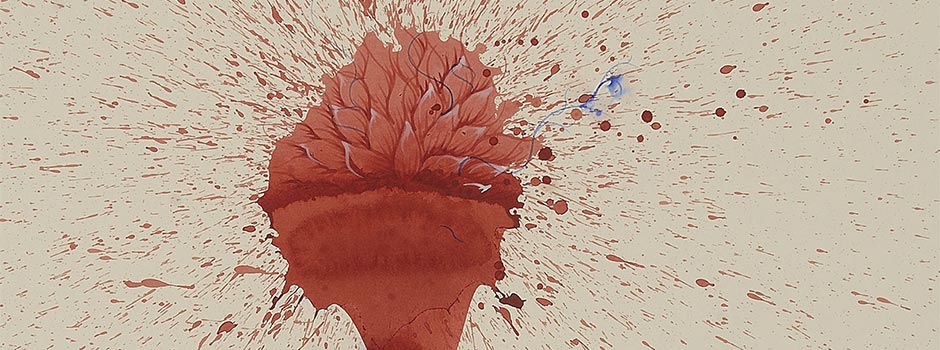
Two of Pakistan’s Leading Contemporary Artists Gandhara-Art presents Imran Qureshi and Aisha Khalid
Feb 20, 2014 Exhibition

Imran Qureshi and Aisha Khalid are pioneers of the Neo Contemporary Miniature Art Movement which emerged from Pakistan in the 1990s. Both are graduates of the National College of Arts in Lahore, Pakistan and have since shown their works in numerous international galleries, biennials, museums and art fairs.
Imran Qureshi has created eight miniature landscapes for this exhibition. In a sense his work here moves away from the abstraction of his larger works towards the formalism of the miniature. His previous landscape miniatures, such as those shown in Berlin last year, were examples of his abstractive imagery creeping into the formalism of the miniature, echoing his large-scale installations. In these landscapes, in contrast, the blood motif is increasingly formal and classical. The abstractive marks are not strangers to the landscape but have moved into and become an actual part of the landscape with blood-red foliate forms. These works are more strongly connected to the miniature and therefore the narrative element is observed with clarity; it is almost like coming home or visiting the source of the tradition. In some of the works the ferocious blood splatter motifs disappear and only the landscapes remain, but there is something disturbing and threatening about these - an underlying violence which leaves one with a greater sense of unease.
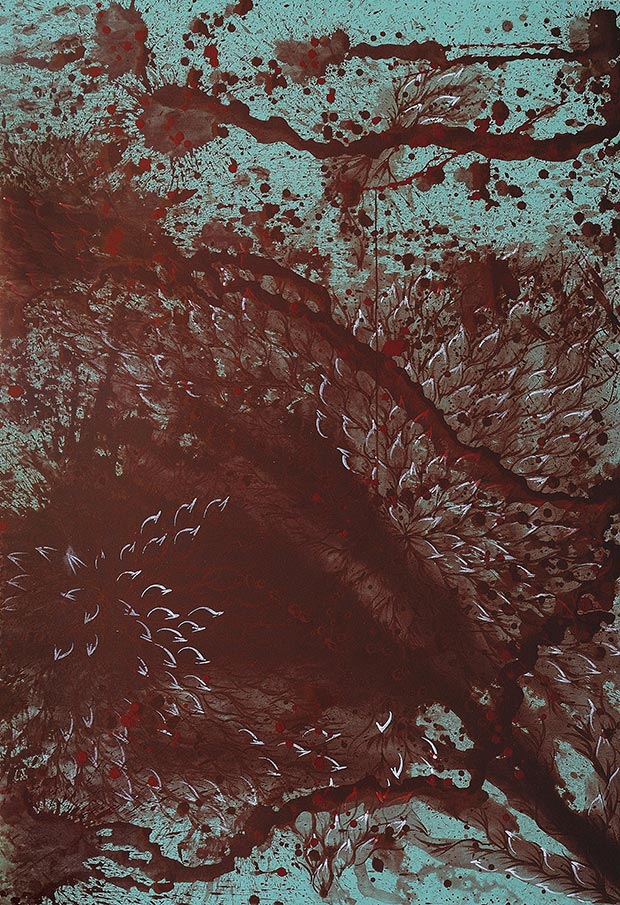 Imran Qureshi (b. 1972) / Midnight Garden, 2014, Acrylic on Canvas, 78x54 Inches / Courtesy of the Artist
Imran Qureshi (b. 1972) / Midnight Garden, 2014, Acrylic on Canvas, 78x54 Inches / Courtesy of the Artist
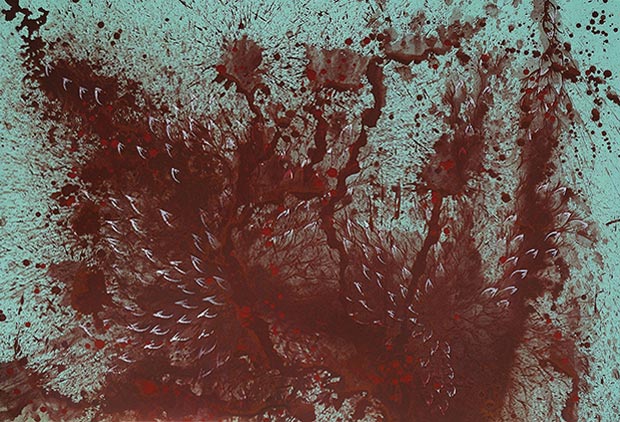 Imran Qureshi (b. 1972) / Midnight Garden, 2014, Acrylic on Canvas, 54x78 Inches / Courtesy of the Artist
Imran Qureshi (b. 1972) / Midnight Garden, 2014, Acrylic on Canvas, 54x78 Inches / Courtesy of the Artist
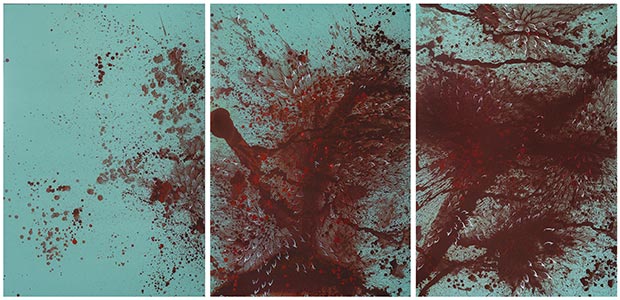 Imran Qureshi (b. 1972) / Midnight Garden, 2014, Acrylic on Canvas, 78x54 Inches each panel x 3 (Triptych) / Courtesy of the Artist
Imran Qureshi (b. 1972) / Midnight Garden, 2014, Acrylic on Canvas, 78x54 Inches each panel x 3 (Triptych) / Courtesy of the Artist
Imran Qureshi translates old Islamic forms of art into a contemporary context with stunning effect. Listed as one of the 'Most Important Artists of 2013', he has enjoyed a meteoric rise in fame during the past three years. In 2013 he was named Deutsche Bank‟s 'Artist of the Year' and had a large solo exhibition at the Deutsche Bank KunstHalle, Berlin. He created site-specific pieces for the exhibition, including a dark walk-through space with various staircases leading to his trademark small paintings under minimal light. He created a similar installation for the Italian Pavilion at the 2013 Venice Biennale. In 2013 he also exhibited at the Museo d'Arte Contemporanea Roma in Rome, marking his first solo show in Italy.
The crowning moment of 2013 for Imran Qureshi was the 'Roof Garden Commission' at the Metropolitan Museum of Art in New York. In this, his first large-scale installation in the United States, Qureshi used his favourite material, red acrylic paint, powerfully to depict the bloodshed caused by violence. In the Roof Garden Commission he extended this blood red motif into intricately painted foliage patterns. Though mingled with the colour of blood, these plant forms symbolized new beginnings and fresh hope. The foliate patterns evoked the luxuriant walled gardens of the Mughals, a favourite subject in Indian miniature painting, and also echoed the nearby verdant foliage of Central Park.
Qureshi has created similar installations for the 2011 Sharjah Biennial, for which he was awarded the Jury Prize; and for the 2012 Sydney Biennial. His work has also been shown at the Singapore Biennial, the Asia Society Museum, New York and MOMA, Oxford. He works in a variety of media including painting, sculpture, video and site-specific installations.
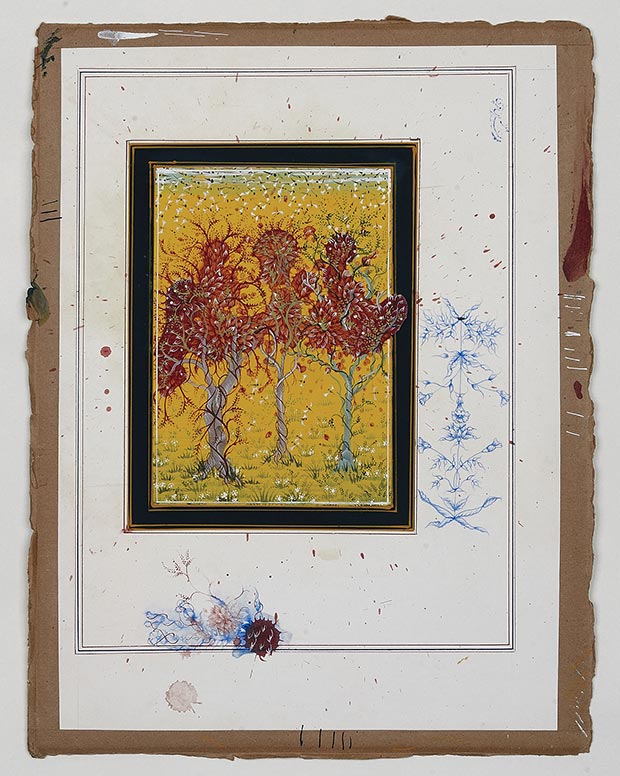 Imran Qureshi (b. 1972) / And will there be a spring, when the garden is all unblighted, 2014, Gold Leaf and Gouache on Wasli (Paper) / Courtesy of the Artist
Imran Qureshi (b. 1972) / And will there be a spring, when the garden is all unblighted, 2014, Gold Leaf and Gouache on Wasli (Paper) / Courtesy of the Artist
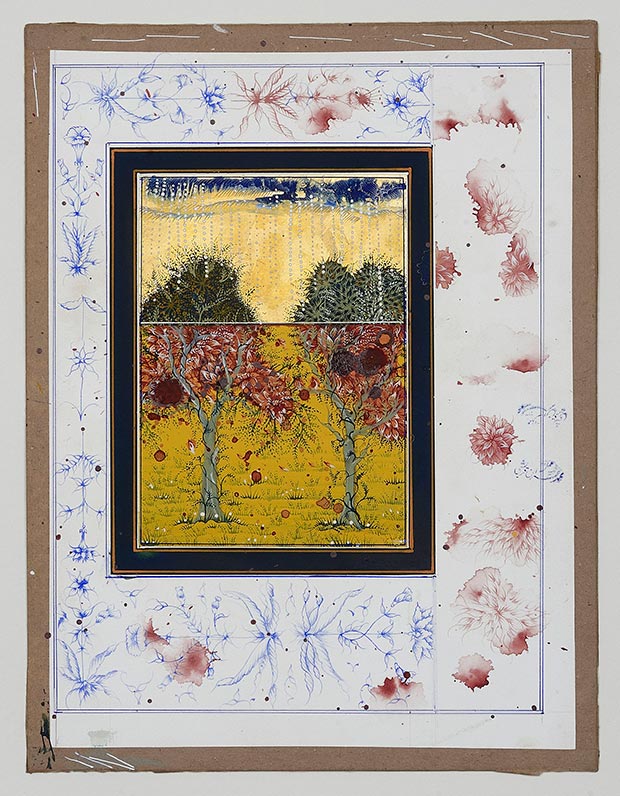 Imran Qureshi (b. 1972) / And will there be a spring, when the garden is all unblighted, 2014, Gold Leaf and Gouache on Wasli (Paper) / Courtesy of the Artist
Imran Qureshi (b. 1972) / And will there be a spring, when the garden is all unblighted, 2014, Gold Leaf and Gouache on Wasli (Paper) / Courtesy of the Artist
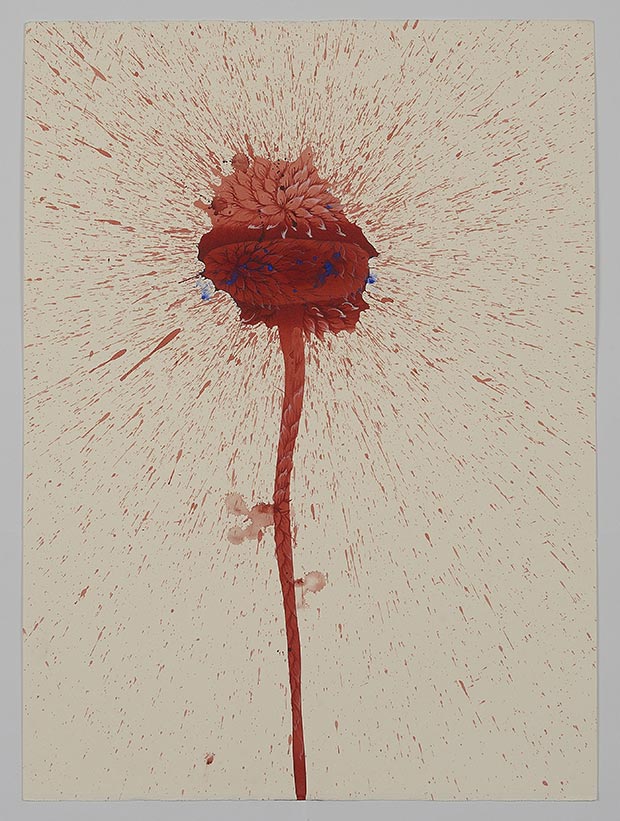 Imran Qureshi (b. 1972) / Love Me, Love Me Not, 2014, Acrylic & Gouache on Paper, 30x22 Inches / Courtesy of the Artist
Imran Qureshi (b. 1972) / Love Me, Love Me Not, 2014, Acrylic & Gouache on Paper, 30x22 Inches / Courtesy of the Artist
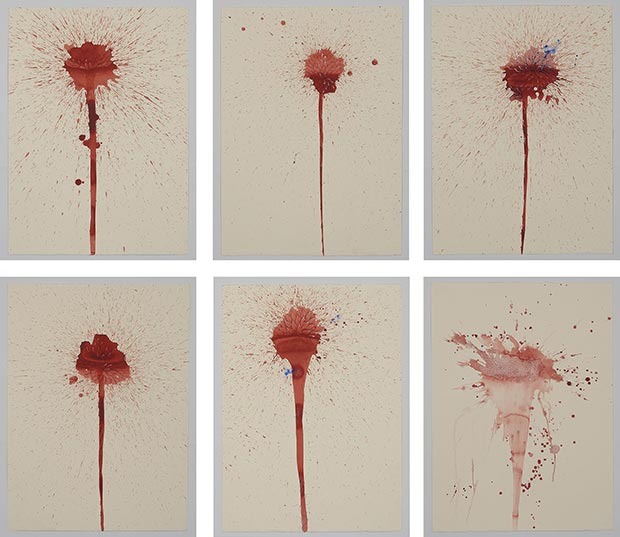 mran Qureshi (b. 1972) / Love Me, Love Me Not, 2014, Acrylic & Gouache on Paper, 30x22 Inches each / Courtesy of the Artist
mran Qureshi (b. 1972) / Love Me, Love Me Not, 2014, Acrylic & Gouache on Paper, 30x22 Inches each / Courtesy of the Artist
In her series of six paintings in this show, Aisha Khalid has expanded on the theme of her earlier works, which explored concepts of spirituality, and the divine. Earlier the 'burqa' or 'veil' in her work symbolised the curtain which conceals the divine and the invisible, though in certain works, the veiled figure also stood for the self. These veils had gaps or slits, which were like glimpses into the invisible. In this series she gone a step further and has physically divided the works. These works are cut and slashed and appear like an exercise to negate the self or the ego. The tulip which emerged in her work at the Rijksakademie, Amsterdam has matured.
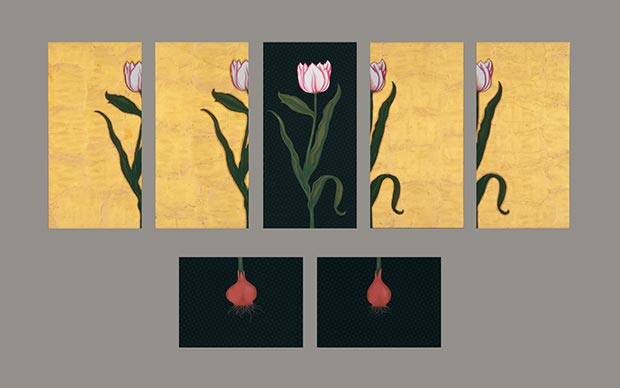 Aisha Khalid (b. 1972) / When I am Silent, 2014, Gouache and Gold Leaf on Paper Board, 6x12 Inches x 5 panels and 7x5.5 Inches x 2 panels / Courtesy of the Artist
Aisha Khalid (b. 1972) / When I am Silent, 2014, Gouache and Gold Leaf on Paper Board, 6x12 Inches x 5 panels and 7x5.5 Inches x 2 panels / Courtesy of the Artist
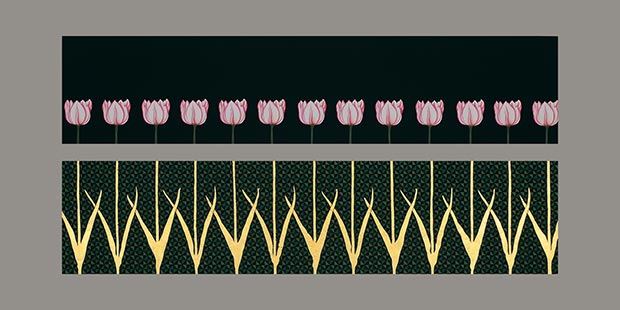 Aisha Khalid (b. 1972) / When I am Silent, 2014, Gouache and Gold Leaf on Paper Board, 10 x 45.5 Inches each panel / Courtesy of the Artist
Aisha Khalid (b. 1972) / When I am Silent, 2014, Gouache and Gold Leaf on Paper Board, 10 x 45.5 Inches each panel / Courtesy of the Artist
 Aisha Khalid (b. 1972) / When I am Silent, 2013, Gouache and Gold Leaf on Paper Board, 8x10 Inches each panel / Courtesy of the Artist
Aisha Khalid (b. 1972) / When I am Silent, 2013, Gouache and Gold Leaf on Paper Board, 8x10 Inches each panel / Courtesy of the Artist
Aisha Khalid has also revitalized the traditional medium of miniature painting, by juxtaposing decorative surfaces with deeply controversial social and political messages. The subject matter and political nature of her work is influenced by her own personal experiences of gender issues, aesthetics, the role of women and power relationships between East and West. Her work explores issues such as cultural expectations and stereotyping, the oppression of women and global politics in the aftermath of 9/11. She works in a wide range of media including painting, sculpture, video and site-specific installations.
Khalid has been working with floral and geometrical patterns for over a decade and her work remains strongly political. She had had numerous solo exhibitions including Larger Than Life at the Whitworth Art Gallery, Manchester, UK in 2012; and Pattern to Follow at The Hong Kong Arts Centre in 2010. Her work has been included in group exhibitions at the 2009 Venice Biennale; the Fukuoka Art Museum, Japan; the Singapore Art Museum; the Institut du Monde Arabe, Paris; and the Victoria and Albert Museum, London. Her work was featured at the Sharjah Biennale in 2011 and the Moscow Biennale in 2013.
In 2012 Aisha Khalid was a winner of the Alice Award (Artist Book category) and in 2011 she was a finalist for the Jameel Prize, an international art prize for contemporary artists inspired by Islamic traditions of art, launched by the Victoria and Albert Museum, London. She was awarded the People's Choice Award for her works including Kashmiri Shawl, a cashmere shawl pierced with 300,000 gold-plated pins creating a traditional paisley pattern. This work was beautiful to behold, yet ferocious in its symbolism. For Khalid, the sharp pins represented the agony of the people in occupied Kashmir. However, she always emphasizes the importance of beauty in her artwork.
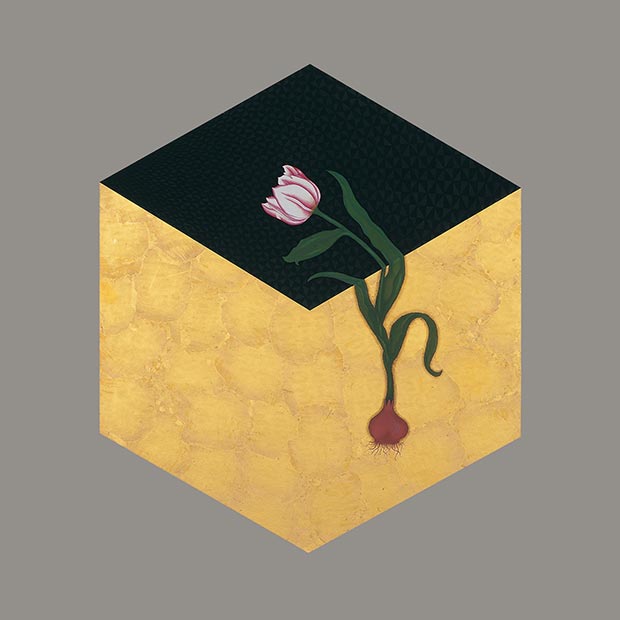 Aisha Khalid (b. 1972) / When I am Silent, 2014, Gouache and Gold Leaf on Paper Board, 20.5x23.5 Inches / Courtesy of the Artist
Aisha Khalid (b. 1972) / When I am Silent, 2014, Gouache and Gold Leaf on Paper Board, 20.5x23.5 Inches / Courtesy of the Artist
 Aisha Khalid (b. 1972) / When I am Silent, 2014, Gouache and Gold Leaf on Paper Board, 10x12 Inches x 2 panels and 6x6 Inches x 1 panel / Courtesy of the Artist
Aisha Khalid (b. 1972) / When I am Silent, 2014, Gouache and Gold Leaf on Paper Board, 10x12 Inches x 2 panels and 6x6 Inches x 1 panel / Courtesy of the Artist
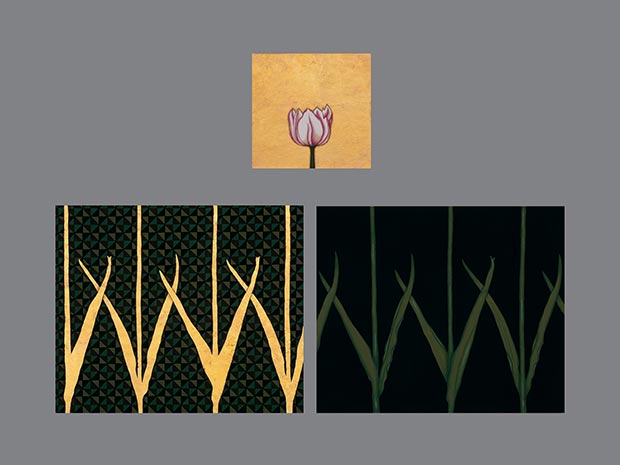 Aisha Khalid (b. 1972) / When I am Silent, 2014, Gouache and Gold Leaf on Paper Board, 7.5x30 Inches / Courtesy of the Artist
Aisha Khalid (b. 1972) / When I am Silent, 2014, Gouache and Gold Leaf on Paper Board, 7.5x30 Inches / Courtesy of the Artist
Gandhara-Art is a curatorial and art publishing organization dedicated to showcasing the work of Pakistan's pioneering generation of modern artists such as Sadequain, as well as the radical artwork of the country's contemporary artists. Since its inception in 2005, it has shown the works of almost fifty artists including Imran Qureshi, Aisha Khalid, Rashid Rana, Faiza Butt, Naiza Khan, Khadim Ali and had also supported Shahzia Sikandar's first public exhibition in Hong Kong. It runs a regular gallery program in its Karachi space and also collaborates with artists to exhibit art works in various media including paintings, photography, etchings, video & sound installations, sculpture, in-situ installations as well as performance art. It was also the first gallery to invite artists, to create site-specific installations in its space.
Gandhara-art takes also takes a strong role in supporting the arts in Pakistan as well as internationally. It has supported and provided funding for exhibitions at public art spaces and museum, such as Para-site Art Space, Hong Kong, The Mohatta Palace Museum, Karachi and The Johnson Museum, Cornell University, USA. It also provided support for the arts & art related initiatives at the Asia Art Archive Hong Kong, the National College of Arts, Lahore and Vasl Arts Collective, Karachi.
Comments
Add a comment